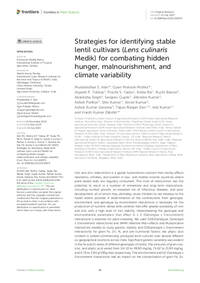Strategies for identifying stable lentil cultivars (Lens culinaris Medik) for combating hidden hunger, malnourishment, and climate variability

Authors:
Iron and zinc malnutrition is a global humanitarian concern that mostly affects newborns, children, and women in low- and middle-income countries where plant-based diets are regularly consumed. This kind of malnutrition has the potential to result in a number of immediate and long-term implications, including stunted growth, an elevated risk of infectious diseases, and poor development, all of which may ultimately cause children to not develop to the fullest extent possible. A determination of the contributions from genotype, environment, and genotype by environment interactions is necessary for the production of nutrient-dense lentil varieties that offer greater availability of iron and zinc with a high level of trait stability. Understanding the genotype and environmental parameters that affect G x E (Genotype x Environment) interactions is essential for plant breeding. We used GGE(Genotype, Genotype x Environment interactions) and AMMI (Additive Main effects and Multiplicative Interaction) models to study genetic stability and GE(Genotype x Environment interactions) for grain Fe, Zn, Al, and anti-nutritional factors like phytic acid content in sixteen commercially produced lentil cultivars over several different six geographical locations across India. Significant genetic variability was evident in the Fe and Zn levels of different genotypes of lentils. The amounts of grain iron, zinc, and phytic acid varied from 114.10 to 49.90 mg/kg, 74.62 to 21.90 mg/kg, and 0.76 to 2.84 g/100g (dw) respectively. The environment and GE (Genotype x Environment interactions) had an impact on the concentration of grain Fe, Zn, and phytic acid (PA). Heritability estimations ranged from low to high (53.18% to 99.48%). The study indicated strong correlation between the contents of Fe and Zn, a strategy for simultaneously increasing Fe and Zn in lentils may be recommended. In addition, our research revealed that the stable and ideal lentil varieties L4076 (Pusa Shivalik) for Fe concentration and L4717 (Pusa Ageti) for Zn content, which have lower phytic acid contents, will not only play an essential role as stable donors in the lentil bio-fortification but will also enable the expansion of the growing area of bio-fortified crops for the security of health and nutrition.
